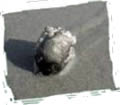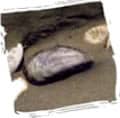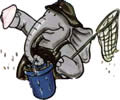- Host
- News
- Sport, Active & Thalasso
- Discover & Experience
- Good to know
- Sustainability
 From March to November, you have the opportunity to go on a search for clues in the mudflats with the Fun Kontor. The secrets of sand spaghetti piles and running mussels are revealed. Which mudflat explorer will discover the smallest snail on the coast first?
From March to November, you have the opportunity to go on a search for clues in the mudflats with the Fun Kontor. The secrets of sand spaghetti piles and running mussels are revealed. Which mudflat explorer will discover the smallest snail on the coast first?
 Mussel loves water
Mussel loves waterThe little black mussel has such a great thirst that it drinks 24 litres of water a day and at the same time cleans the water of pollutants. This little mussel is quite hard-working. Imagine if you had to drink 5 small sand buckets full of water a day, you would have a bubble belly!
 Attention"peeers"!
Attention"peeers"!If you walk into the mudflats directly behind the draining water, you will see small water fountains shooting out of the earth all around you. These water fountains are the fault of the large sand clam. It lives about 25 cm deep in the mudflats.
To reach the mudflat surface to drink, it has a very long neck (siphon) that it stretches out.
 If you now walk across the mudflat floor, you will shake the ground like a giant in dwarf land. The sand clam is startled and quickly retracts its neck. In doing so, it pushes all the water out of its throat in a flash and "pees". This mussel is therefore also called "peeer" by the locals.
If you now walk across the mudflat floor, you will shake the ground like a giant in dwarf land. The sand clam is startled and quickly retracts its neck. In doing so, it pushes all the water out of its throat in a flash and "pees". This mussel is therefore also called "peeer" by the locals.
 If, while walking on the mudflats, you have the feeling that there are small pebbles under your feet, then you have discovered a mussel bed. At this point, carefully start digging with your hands in the mudflat floor. After only 2 cm you will come across living mussels, which you can recognise by the way they press their two shell halves tightly together. Rinse the mussels with a little seawater and place them on the mudflats. After a while, the cockles will stretch out their little burrowing feet and start to walk across the mudflats or burrow in again - they don't like dryness.
If, while walking on the mudflats, you have the feeling that there are small pebbles under your feet, then you have discovered a mussel bed. At this point, carefully start digging with your hands in the mudflat floor. After only 2 cm you will come across living mussels, which you can recognise by the way they press their two shell halves tightly together. Rinse the mussels with a little seawater and place them on the mudflats. After a while, the cockles will stretch out their little burrowing feet and start to walk across the mudflats or burrow in again - they don't like dryness.
 Earthworm and lugworm are relatives like you and your cousin and both live in the soil. The earthworm in your garden lives in a tube that looks like the letter "I", the lugworm in the mudflat, whose tube looks like the letter "U".
Earthworm and lugworm are relatives like you and your cousin and both live in the soil. The earthworm in your garden lives in a tube that looks like the letter "I", the lugworm in the mudflat, whose tube looks like the letter "U".
The earthworm has to leave its burrow when it rains so that it doesn't drown. It breathes with a lung like we humans do. The lugworm can stay in its burrow because it breathes with gills like a fish.
 This only exists in Cuxhaven! The mudflat wagons (horse-drawn carts) have been travelling to the island of Neuwerk at low tide for over 100 years to supply the people living there with food and mail. You definitely have to come along! Departure from Duhnen, Döse and Sahlenburg.
This only exists in Cuxhaven! The mudflat wagons (horse-drawn carts) have been travelling to the island of Neuwerk at low tide for over 100 years to supply the people living there with food and mail. You definitely have to come along! Departure from Duhnen, Döse and Sahlenburg.
 Groynes are not bathing bridges
Groynes are not bathing bridgesWhen you are on the beach, you will see a stone dam leading into the water about every 100 metres. These stone dams are called groynes and serve to regulate the Elbe. Between the groynes, the water flows more slowly and therefore does not have as much force. So when the North Sea pushes a lot of water into the Elbe River during a storm surge and the water is rising (high tide), the water can't take as much of our beach sand up the Elbe to Hamburg. Quite clever - the construction of the groyne!